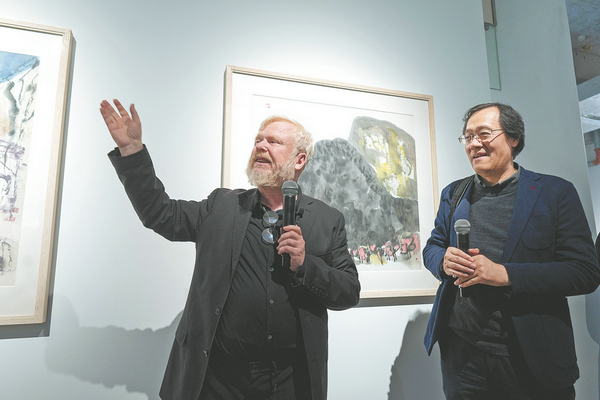To think ink
An exhibition reveals how a French philosophy professor explores thoughts beyond aesthetics through his Chinese paintings, Wang Xin reports in Shanghai.

Vermander introduces more than 60 ink paintings created over the past decade at the exhibition. GAO ERQIANG/CHINA DAILY
Benoit Vermander, a French professor at Fudan University's School of Philosophy in Shanghai, has found a liberatory mode of self-expression in Chinese ink paintings. Under the artist name of Bendu, Vermander — who is also known by his Chinese name Wei Mingde — is exhibiting more than 60 Chinese ink paintings, most of which he created over the past decade.
This year marks the 60th anniversary of the establishment of diplomatic ties between China and France. The exhibition, which is part of the university's celebration of this occasion, will run through Thursday on Fudan's campus.
Through the art at the exhibition, which focuses on themes such as animals, landscapes and people, visitors can learn about the artist's intimate relationship with nature and daily life, and see the integration of Western composition and Chinese ink painting skills.
Vermander's story with Chinese ink painting dates back three decades.
He was born in France in 1960, and has been fond of painting since childhood. However, vision and hearing losses made it hard for him to advance his painting skills, as his brushwork was often critiqued as not being "clean".
The turning point came in 1987, when Vermander made his first visit to China and was enchanted by Chinese calligraphy.
"When I first came to China, I was shown calligraphic works. I was really astounded, both by the meanings and the dynamics of the inscriptions," he recalls.
"I was very impressed by calligraphy as an art in which finally I could find my own way of expression. I also realized that I could create much more freely than in classical Western painting, as even the 'not clean' part of my works can be a good part of a creation with ink. So, I decided to study classical Chinese and calligraphy."
After three to four years of study, Vermander developed steady penmanship, which is a critical skill in both calligraphy and ink painting. From 1994, he shifted his focus to Chinese ink painting.

Professor Benoit Vermander and Shen Yubing, another professor at Fudan University's School of Philosophy, at the opening ceremony of the exhibition on April 10. GAO ERQIANG/CHINA DAILY
"It was, for me, a change of life. I came from France, but China gave me the biggest present — that is, the courage to create. It allowed me to find a way of immersing myself in another culture, philosophy and in another art practice," he says.
Vermander has visited many places across China over the past three decades, including Sichuan province in Southwest China, where he studied Chinese painting and met his mentor and closest friend, painter Li Jinyuan.
Vermander says that Li asked him to draw subjects from his childhood in France, because his memories would not be the same.
"He gave me pencils and paper and asked me to quickly draw the memories of my childhood. And when I had done that, he said he respected who I am, my past, my sensitivity, and he showed me how to express them with ink according to the method of Chinese painting."
This may also explain the integration of Western and Chinese painting styles in Vermander's works.
Shen Yubing, another professor at the university's School of Philosophy, says that the Chinese ink paintings at the exhibition reflect the influences of Western painters, such as Henri Matisse (1869-1954) and Paul Cezanne (1839-1906), as well as of Chinese elements such as folk arts.
Vermander's research focuses on Chinese religions. He is committed to interpreting Chinese classics to promote cultural exchange between China and the West. Although philosophy and Chinese ink painting might seem disparate at first glance, Vermander says that they are actually closely connected.
"Philosophy is not about data or information but about thinking. You have to be able to confront yourself, to look at yourself and go into yourself. Thinking about problems, especially philosophical problems, is not the work of the brain but involves the participation of the whole being, including your creativity, physical experiences, senses, imagination, emotions and bodily feelings," he says.
"Every one of my Chinese ink paintings is also a philosophical article."
He adds that a good work — of either art or philosophy — should allow diversity in meaning, as each one can have a different connection to his work.
Vermander says that he regards his paintings as integrated expressions of himself with daily life. Through the ink brush, he hopes to freely show his inner explorations, dynamics and the movement of his heart.
"What I like most in Chinese ink painting is the dynamism, mobility and freedom it allows you. I am not skilled in Western painting as I have bad eyes, and it is not my character to be cautious, careful and plan everything. With Chinese calligraphy and ink painting, I could liberate my inner wildness. My only future goal is to have more time for writing and painting — that's it," he says, laughing.
